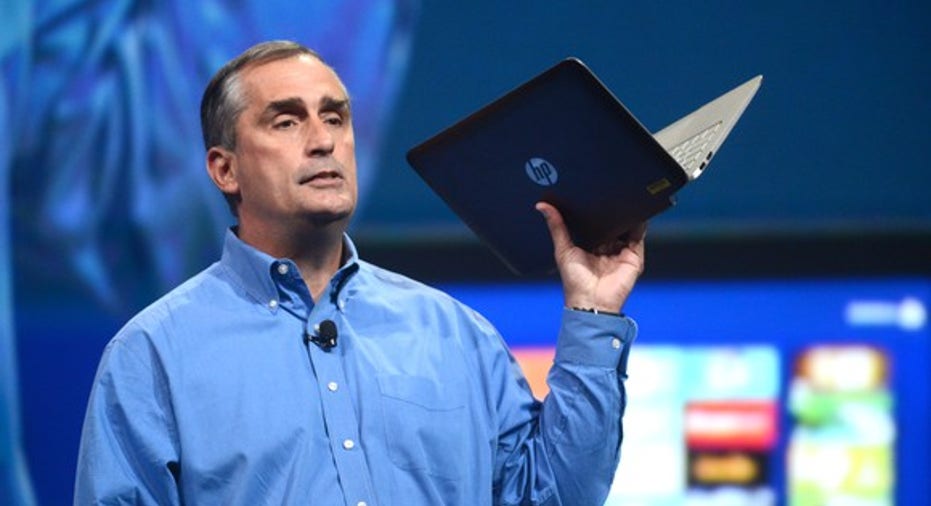Intel Stock History: Can the Chip Giant Thrive in the Post-PC Era?

Image Source: Intel.
For a company that produces and sells a product consumers never even see, semiconductor titan Intel's (NASDAQ: INTC) incredible place within our broader consumer consciousness speaks to both its business acumen and resounding success.
Few companies have dominated their industries like Intel Corporation, the semiconductor giant whose chips power an impressive share of our increasingly digital lives. Unsurprisingly, Intel stock has also proven to be an investment for long-term investors, turning $1,000 in 1972 to over $2.6 million, or $3.2 million with dividends reinvested. Today, Intel's chart reveals a company in transition.
Data Source: Google Finance.
However, this sampling of financial data speaks to a small piece of Intel's vaunted corporate history. As such, let's delve deeper into Intel Corporation's past, and examine what the future likely holds for its shares.
Intel, Wintel, and mobile
Intel's history still stands as one of the most seminal and influential success stories in Silicon Valley. Founded by two former engineers from Fairchild Semiconductor -- Gordon Moore, of Moore's Law fame, and Robert Noyce -- Intel became a success nearly overnight. Moore and Noyce started Intel Corporation in 1968 with help from an investment from legendary venture capitalist Arthur Rock, and conducted Intel's IPO only three short years afterward. The recently deceased Andy Grove, the CEO who ran Intel in its most dominant years, was hired as the company's third employee.
Through the '60s and '70s, Intel's business primarily involved producing memory chips, and the company profited tremendously. In 1970, Intel's sales totaled just $4 million, and by 1973, the chipmaker passed $3 million in monthly revenue.However, it wasn't until Intel moved headlong into microprocessors -- the chips that executed the central processing task in computers -- that it ascended to the dominance for which it's commonly known.
Intel first aligned itself with early PC-era power IBM, then expanded its presence along with Microsoft's Windows to form the operating system and processor alliance that completely dominated the PC market. In 1983, Intel passed the $1 billion mark in annual revenue.
Going forward, Intel's PC microprocessor business controlled the vast majority of its market. However, as is so often the case in business, Intel's understandable fixation on dominating the PC market also hindered its ability to foresee the coming revolution in smartphones, a reality to which Intel continues to adapt today.
Image Source: Intel.
Intel Corporation in the post-PC era
For years, Intel's PC chips and its x86 architecture succeeded by virtue of a singular focus on performance. With PCs and laptops easily connected to a power source, power efficiency understandably mattered little. It wasn't until the dawn of the smartphone era where power efficiency and performance became equally important considerations for chipmakers.
While Intel failed to foresee this change, or simply refused to alter its business tactics in the face of it, other semiconductor architecture designers didn't, notably the British chip design firm ARM Holdings, whose chip architecture has supplanted Intel's as the de facto standard on which all mobile chips are designed. Intel has tried for years to dent ARM Holdings' market share in mobile, to little avail, and it seems unlikely Intel will directly participate in powering mobile devices. Crucially for Intel stock's outlook, though, that doesn't mean the company cannot find success in the post-PC era.
In reaction to its lot in mobile, Intel has more recently tailored a new strategy to play to its strength in the data center servers that constitute the backbone of the cloud computing and mobile revolutions. What's more, Intel has also aggressively developed new classes of chips that cater to coming tech trends including the Internet of Things.
At present, the tangible signs of progress remain in flux. In Intel's most recent quarter, Intel's sever chip segment saw revenue increase 5%, which some analysts commented seems softer than expected. Intel's IoT chip business saw sales increase 2% compared to the year prior. However, Intel's PC chip business, which still produces the bulk of its revenues, saw its sales decline 3%.
Simply said, Intel remains a business still struggling to balance its legacy monopoly in PC chips with a less certain future. To be sure, Intel will not fully fade away in the decades to come, but its financial profile seems likely to change as we move deeper into the post-PC era.
A secret billion-dollar stock opportunity The world's biggest tech company forgot to show you something, but a few Wall Street analysts and the Fool didn't miss a beat: There's a small company that's powering their brand-new gadgets and the coming revolution in technology. And we think its stock price has nearly unlimited room to run for early in-the-know investors! To be one of them, just click here.
Andrew Tonner has no position in any stocks mentioned. The Motley Fool owns shares of Microsoft. The Motley Fool recommends Intel. Try any of our Foolish newsletter services free for 30 days. We Fools may not all hold the same opinions, but we all believe that considering a diverse range of insights makes us better investors. The Motley Fool has a disclosure policy.